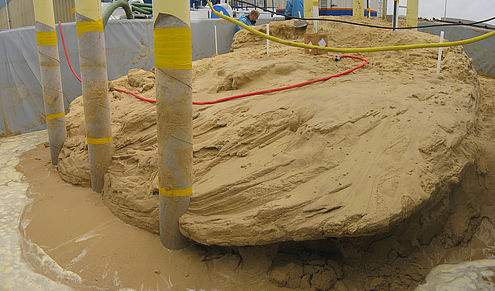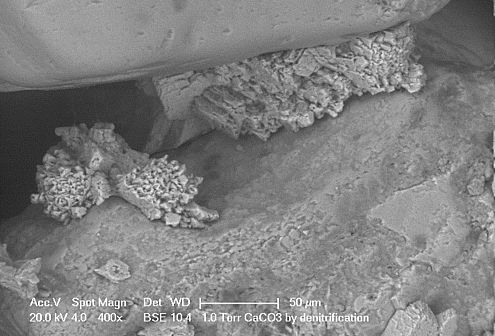Bio-geotechnical engineering
Bio-Based Geo & Civil Engineering for a Sustainable Society (STW: Perspectief, BioGeoCivil) aims to develop biology-based processes and products in order to substantially mitigate the pressure from the Geo & Civil Engineering activities on the environment. The challenge is to develop biology-based materials, technology and processes that solve engineering challenges such as resource depletion, material production, strength, permeability, climate control, air quality improvement and more, while at the same time reducing the impact on the environment compared to traditional solutions.

The exposed cemented sand body of the 100m experiment reported by Van Paassen et al. (key societal output, 2010).
The BioFix project is a follow-up of a PhD project, where in-situ precipitation of CaCO is used to cement sand or gravel in order to increase the strength of the soil. The approach which based on using the enzyme urease out to be very costly because bacteria had to be grown in a bioreactor and the ammonium produced by the process had to be removed. Within BioFix, an alternative approach based on nitrate reduction is being investigated, with the added benefit of reducing the liquefaction potential of loose sands and susceptibility for piping under dykes.

ESEM image of sand cemented by calcium carbonate crystals precipitated by micro-organisms as a bi-product of their metabolism.
In the BioCoPro project, biogeochemical processes involved in the corrosion of metal objects in the sub-surface are investigated. The ambition is to understand the interaction between the corroding steel object and the microbial ecosystem processes in the soil in the direct surroundings, and thereby identify those processes and microbial communities which may prevent corrosion of steel. Novel experimental and numerical methods have been developed to visualise and quantify the effect of the microbial corrosion process on the characteristics of porous media, and some of the results may lead to novel approaches for preventing corrosion.
The Lift-Up of Lowlands project focuses on understanding the processes involved in the ripening of dredged materials and the impact these processes have on the mechanical stability of the ripened sludge.
An additional project, related to but not part of BioGeoCivil, on biofilm growth in fractured tight gas reservoirs. The research developed visualisation experiments to show flow diversion by biofilms.